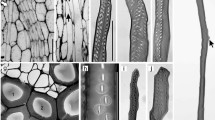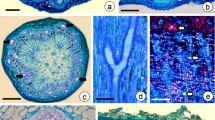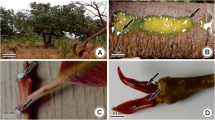Summary
The development of the testa was studied inErythrina lysistemon using both light and electron microscopy. Cells of the outer epidermis of the outer integument divide anticlinally and undergo radial elongation to form a palisade layer. The outer tangential walls are thickened at an early stage, and deposition of fluted thickenings on the radial walls occurs at maturity. Palisade cells in the hilar region differentiate from sub-funicular tissue, and at maturity the outer ends of the cells undergo extensive deposition of secondary walls and associated lignification. The light line occurs at the junction between the outer, thickened portions of the cells and the inner, less thickened portions. An electron-translucent (suberised) cap develops in the outer tangential walls of the palisade cells at a late stage. Microtubules and dictyosomes are closely associated with the developing thickenings in palisade and tracheid bar, and the microtubules run parallel to the wall microfibrils. Differentiation of the tracheid bar coincides with final secondary wall deposition and lignification in the hilar palisade. The cells of the tracheid bar are dead at maturity, but are surrounded by sheaths of elongate parenchyma.
Similar content being viewed by others
References
Aitken, Y., 1939: The problem of hard seeds in subterranean clover. Proc. Roy. Soc. Victoria51, 187–213.
Chandravadana, P., 1963: A note on the embryology ofErythrina indica. Curr. Sci.32, 229–230.
Corner, E. J. H., 1951: The leguminous seed. Phytomorphology1, 117–150.
Hall, J. L., Flowers, R. S., Roberts, R. M., 1978: Plant Structure and Metabolism. London: Longman.
Hamly, D. H., 1932: Softening of the seeds ofMelilotus alba. Bot. Gaz.43, 345–375.
Harris, W. M., 1983: On the development of macrosclereids in seed coats ofPisum sativum L. Amer. J. Bot.70, 1528–1535.
—, 1984: On the development of osteoclereids in seed coats ofPisum sativum L. New Phytol.98, 135–141.
Holtzman, E., Novikoff, A. B., 1984: Cells and Organelles, 3rd Ed. Philadelphia: Saunders College Publishing.
Hyde, E. O. C., 1954: The function of the hilum in somePapilionaceae in relation to the ripening of the seed and the permeability of the testa. Ann. Bot.18, 241–256.
Lersten, N. R., 1982: Tracheid bar and vestured pits in legume seeds (Leguminosae: Papilionoideae). Amer. J. Bot.69, 98–107.
McNaughton, J. E., 1976: Embryolgy ofErythrina caffra Thunb.: sporogenesis and gametogenesis. J. S. Afr. Bot.42, 395–400.
Martin, J. S., Watt, J. R., 1944: The strophiole and other seed structures associated with hardness inMelilotus alba L. andM. officinalis Willd. Iowa State J. Sci.18, 457–469.
Mollenhauer, H. H., 1974: Post staining sections for electron microscopy. Stain Tech.49, 305–308.
Newcomb, E. H., 1969: Plant microtubules. Ann. Rev. Plant Phys.20, 253–288.
Northcote, D. H., Pickett-Heaps, J. D., 1966: A function of the Golgi apparatus in polysaccharide synthesis and transport in the root-cap cells of wheat. Biochem. J.98, 159–167.
Pickett-Heaps, J. D., Northcote, D. H., 1966: Relationship of cellular organelles to the formation and development of the plant cell wall. J. exp. Bot.17, 20–26.
Polhill, R. M., Raven, P. H., (ed.) 1981: Advances in Legume Systematics, Vol. 2 (Proceedings of the International Legume Conference, Kew). Kew: Royal Botanic Gardens.
Quinlivan, B. J., 1971: Seed coat impermeability in legumes. Journal of the Austr. Inst. Agric. Soc.37, 283–295.
Ray, P. M., Shininger, T. L., Ray, M. M., 1969: Isolation of Β-glucan synthetase particles from plant cells and identification with Golgi membranes. Proc. Natl. Acad. Sci. U.S.A.64, 605.
Reeve, R. M., 1946: Ontogeny of the sclereids in the integument ofPisum sativum L. Amer. J. Bot.33, 806–816.
Spurr, A. R., 1969: A low-viscosity epoxy resin embedding medium for electron microscopy. J. Ultrastruct. Res.26, 31–43.
Sterling, C. 1954: Development of the seed coat of Lima Bean (Phaseolus lunatus L.). Bull. Torrey Bot. Club81, 271–287.
Watson, D. P., 1948: Structure of the testa and its relation to germination in thePapilionaceae TribesTrifolieae andLoteae. Ann. Bot.12, 385–409.
Werker, E., Marbach, I., Mayer, A. M., 1979: Relation between the anatomy of the testa, water permeability and the presence of phenolics in the genusPisum. Ann. Bot.43, 765–771.
Author information
Authors and Affiliations
Rights and permissions
About this article
Cite this article
Manning, J.C., van Staden, J. The development and ultrastructure of the testa and tracheid bar inErythrina lysistemon Hutch. (Leguminosae: Papilionoideae). Protoplasma 129, 157–167 (1985). https://doi.org/10.1007/BF01279913
Received:
Accepted:
Issue Date:
DOI: https://doi.org/10.1007/BF01279913




